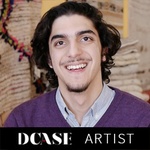The Magic Carpet: A story with music
A new version of a tragic love story, "The Magic Carpet" is a new theatre production set along the Moroccan-Algerian border and centering on contemporary border conflicts through the lens of star-crossed lovers. This is a new work produced by Borderline Theatre Project--a mobile, transnational theatre collective of which I am co-founder and artistic director. We develop new works based on classic stories, myths, legends and oral traditions, and center them around contemporary border conflicts. During my research along the Spanish-Moroccan and Moroccan-Algerian borders, it became clear that the story of star-crossed lovers held particular resonance in this region. Our lives are full of borders, from those that exist between Chicago neighborhoods to the military outposts between Morocco and Algeria. Through storytelling, I aim to uncover and share our common struggles, and our common joys, with people across the world.
About This Project
While in Morocco as a Fulbright grantee, I came across a rug made with Moroccan patterns, but with Algerian colors. The merchant had no idea from where it came, but that it was something of an anomaly. Traditionally, the bottom of the rug is left open, so that stories and messages can be woven into the bottom of the rug, as time goes on. I brought this rug back to Chicago with me and now this rug is the framing device for our production. Using recorded oral histories from residents of the Moroccan border city of Oujda, I am using my research to develop The Magic Carpet, a new version of the world’s most tragic love story set along the Moroccan-Algerian border.
With the support of 3AP, I hope to produce a staged reading of this piece in late May. Following the reading, and the script workshop process that would accompany it, I plan to return to Morocco in June to conduct a free admission workshop reading of the piece in Oujda, the largest Moroccan city on the Algerian border. The funds I am raising will allow me to pay all of the artists involved with the project a modest stipend, rent the spaces needed, purchase props, and hire a videographer to capture both productions.
I hope you will join us as we weave this new story of love.
Thank yous
Contribute any amount or choose from the levels below.
- $25Inclusion in the donor section of our program and website ($0.00 is tax deductible.)
- $50Bar of organic artisan soap and bottle of essential oil from Madini's Perfumes in Tangier and inclusion in the donor section of our program/website ($0.00 is tax deductible.)
- $100Arabic calligraphy personal note or poem, organic artisan soap, and inclusion in the donor section of our program/website ($0.00 is tax deductible.)
- $250Framed unique photo from my research trip in Morocco, inclusion in the donor section of our program/website, and a hand-woven "handira" textile ($0.00 is tax deductible.)
- $500Small hand-woven Moroccan rug and inclusion in the donor section of our program/website ($0.00 is tax deductible.)
- $1000Unique coverlet and pillow set, woven by a women's cooperative in Figuig, Morocco (a village in the Sahara desert along the border with Algeria) and inclusion in the donor section of our program/website ($0.00 is tax deductible.)

George Bajalia
George Bajalia is a Chicago based theatre artist and cultural critic. His research interests lie at the intersection of cultural globalization, identity performance, and transnationalism within the Mediterranean region. Previously he was a Fulbright Scholar in Morocco, where he adapted …
-
Update 1: Featured on Chicago Artists Resource!Posted on March 11, 2014
Check out my feature on Chicago Artists Resource's series "GRANTED" for more information about the DCASE grant that brought us to Morocco this September!
"When we approached DCASE about recommending a candidate for a successful theater-oriented grant recipient, Director of Cultural Grants Allyson Esposito responded with two words: George Bajalia. Bajalia's pitch for the Individual Artist Grant in 2013 was for research funding to travel to the frontier of Morocco and Algeria. There, he would gather materials to produce a high-quality play that showcased those cultures to a Chicago audience.Bajalia is interested in raising awareness through accessible storytelling, focusing on the geopolitical realities of people and the arbitrary borders that define or confine them."
http://www.chicagoartistsresource.org/articles/granted-george-bajalia
Update 2: Article series on Muftah.OrgPosted on March 11, 2014As a staff writer for online magazine Muftah.Org, I've been writing a series of articles on political and social events along the border between Morocco and Algeria. Check out the timeline we published this fall, and stay tuned for more article upates.
"
Over the past several weeks, the conflict over the Western Sahara between Morocco and Algeria has resurfaced.
November 6 marked the 38th anniversary of the historic “Green March,” when approximately 350,000 Moroccans marched from the southern city of Tarfaya toward the then Spanish-held Saharan provinces.
The march—hailed by Moroccan King Hassan II as liberating Africa’s final colony—resulted in the division of the Spanish (or “Western”) Sahara between Morocco and Mauritania, setting the stage for a long standing conflict between the People’s Front for the Liberation of Saguia Al Hamra and Rio De Oro (known by its Spanish name of Frente POLISARIO) and the Kingdom of Morocco.
With the Cold War raging hot, the conflict quickly deteriorated into a standoff between NATO-backed Morocco and the POLISARIO, which was supported by Soviet-allied Algeria.
For human rights activists and politicians in the greater Maghreb region, the “Sahara issue” has remained ever-pressing.
But, over the last forty-years, the Western Sahara has come back into the limelight for much of the rest of the world during moments of violence and friction between Morocco and Algeria..."
http://muftah.org/whose-sahara-nationalism-human-rights-and-stability-in-north-africa/
Update 3: Hyphen, views from the Moroccan-Algerian BorderPosted on April 02, 2014
Originally Published by Signs of Seeing
http://signsofseeing.wordpress.com/2013/10/23/hyphen-views-from-the-moroccan-algerian-border/
North Africa and Southern Europe are divided by a sea, a wide sea, yes, but a sea that for many centuries was little more than a river. Families lived on either side, and still do. Now, however, their movements are governed by national and international bodies with whom they have little relation. Along the eastern edge of Morocco, along the border between Morocco and Algeria, the discrepancy between colonially imposed borders and the people who they separate is pronounced. On the Moroccan side, people wait with knapsacks to unload the cut-rate cigarettes and medicines smuggled in from Algeria. Just outside of Saidia, people stop on the side of the road to wave across a ditch. In Saidia proper, poles and rope demarcate the border on the beach, and military keep watch to make sure that no one crosses in international waters.
In this video, I document a journey down to Figuig to Saidia, and back to Tangier. Taking the ferry from Tangier to Algericas, I crossed from Moroccan waters, into international waters, and into Spanish territory all within 45 minutes. I spent the majority of that time looking back towards Tangier, a white city on a hill, a city I had called home for nearly two years. Just a few short days earlier, I had crossed from Nador into Melilla, a Spanish enclave nestled on Morocco’s coast. A few days later, I would be crossing from La Linéa de Concepcion, Spain into Gibraltar, United Kingdom, and flying out from Gibraltar to London. At the outset of this journey, 2 continents, 3 countries, I spent my time on the ferry looking back. As I looked around me, however, I saw that I was one of the few people gazing back. Most people on the boat, whether business regulars or first time travelers to Spain, were looking forwards. They were looking out to the next step, snapping photos and recording videos of what was to come.
During my time in Tangier, I looked out across the Straits of Gibraltar to Spain and tried to understand how my friends who grew up gazing out across this sea possibly felt about my own travels. I was embarrassed about the privilege I held just by nature of my birth. Tangier was, for me, a nodal point; a point from which I was able to see the world, take ferries to planes to trains to buses and arrive again, safely at the intersection of the Atlantic and the Mediterranean. During these years, marked by coming and going from a city with porous borders and a strong informal economy, I came to realize that the passport I carry is the most valuable thing I have, and it doesn’t even belong to me. Driving from Figuig, in the southeast corner of Morocco, to Saidia, in its northeast corner, I carried it in my front pocket. I entertained some fantasy that I would be able to cross the border at some point, as long I had those helpful papers. It was a fantasy and nothing more. And I understood a little bit. Still no answers, but I’m closer to asking the right questions.
Update 4: Returned from Morocco!Posted on July 03, 2014The Magic Carpet Team has just returned from Morocco! During this trip, we traveled through the Middle Atlas region learning about the process of rug weaving, and profiling the artisans involved for a documentary project the team is doing in conjunction with The Magic Carpet.
We set out to answer the question: What makes the magic carpet magic? The answers may surprise you... Chicago based supporters, stayed tuned for information on a showcase/auction event on July 13th at Hannoun Rugs from Morocco, 2140 West North Avenue in Wicker Park. At 4pm, we will showcase photos and videos from this trip, oral histories of the Morocco-Algerian border, and auction off rugs and other artisan crafts from our trip! We'll also be providing a first look at some of the material from the play itself, so mark your calendars!In the meantime, start watching your mailboxes! Your supporter thank you gifts are coming your way!
-
-
Heather Gilbert
-
Austin Perry
-
Maryam Jamshidi
-
Sandra Ossi
-
Nadine Salem
-
Susan Raine
-
Pamela Murray
-
Carol Hammell
-
Linda Hassan
-
George and Diane Bajalia
-
Elaine Salem
-
Bill Koch
-
james weaver
-
JASON FRALER
-
Joseph Seay
-
Anonymous Supporter
-
Gene Curtin
-
Lisa Roberts
-
Taylor Smith
-
shadia salem
-
Julie Stagliano
-
Anonymous Supporter
-
Barbara Whitman
-
Jesse Bowman
-
Marcia Festen
-
L.C. Bernadine
-
Jamil Khoury
-
Dave & Lyn Montgomery
-
Ray Driver
-
Anonymous Supporter
Thank you to the following for contributing to 3Arts with the recommendation that we support this project.
-

3AP Presenting Partner:
Additional support provided by:


